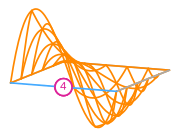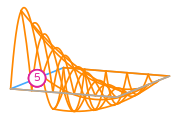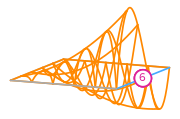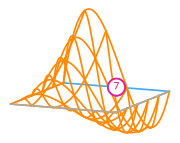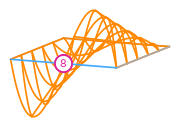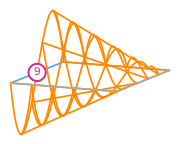an encyclopedia of finite element definitions
Degree 2 Tiniest tensor on a quadrilateral
◀ Back to Tiniest tensor definition page
- \(R\) is the reference quadrilateral. The following numbering of the subentities of the reference is used:
- \(\mathcal{V}\) is spanned by: \(1\), \(y\), \(y^{2}\), \(x\), \(x y\), \(x y^{2}\), \(x^{2}\), \(x^{2} y\), \(x^{2} y^{2}\), \(2 x \left(- 2 x^{2} y + 2 x^{2} + 3 x y - 3 x - y + 1\right)\), \(2 x y \left(2 x^{2} - 3 x + 1\right)\), \(2 y \left(- 2 x y^{2} + 3 x y - x + 2 y^{2} - 3 y + 1\right)\), \(2 x y \left(2 y^{2} - 3 y + 1\right)\)
- \(\mathcal{L}=\{l_0,...,l_{12}\}\)
- Functionals and basis functions:

\(\displaystyle l_{0}:v\mapsto v(0,0)\)
\(\displaystyle \phi_{0} = 10 x^{3} y - 10 x^{3} + 9 x^{2} y^{2} - 27 x^{2} y + 18 x^{2} + 10 x y^{3} - 27 x y^{2} + 26 x y - 9 x - 10 y^{3} + 18 y^{2} - 9 y + 1\)
This DOF is associated with vertex 0 of the reference element.
\(\displaystyle \phi_{0} = 10 x^{3} y - 10 x^{3} + 9 x^{2} y^{2} - 27 x^{2} y + 18 x^{2} + 10 x y^{3} - 27 x y^{2} + 26 x y - 9 x - 10 y^{3} + 18 y^{2} - 9 y + 1\)
This DOF is associated with vertex 0 of the reference element.
\(\displaystyle l_{1}:v\mapsto v(1,0)\)
\(\displaystyle \phi_{1} = x \left(- 10 x^{2} y + 10 x^{2} + 9 x y^{2} + 3 x y - 12 x - 10 y^{3} + 9 y^{2} - 2 y + 3\right)\)
This DOF is associated with vertex 1 of the reference element.
\(\displaystyle \phi_{1} = x \left(- 10 x^{2} y + 10 x^{2} + 9 x y^{2} + 3 x y - 12 x - 10 y^{3} + 9 y^{2} - 2 y + 3\right)\)
This DOF is associated with vertex 1 of the reference element.
\(\displaystyle l_{2}:v\mapsto v(0,1)\)
\(\displaystyle \phi_{2} = y \left(- 10 x^{3} + 9 x^{2} y + 9 x^{2} - 10 x y^{2} + 3 x y - 2 x + 10 y^{2} - 12 y + 3\right)\)
This DOF is associated with vertex 2 of the reference element.
\(\displaystyle \phi_{2} = y \left(- 10 x^{3} + 9 x^{2} y + 9 x^{2} - 10 x y^{2} + 3 x y - 2 x + 10 y^{2} - 12 y + 3\right)\)
This DOF is associated with vertex 2 of the reference element.
\(\displaystyle l_{3}:v\mapsto v(1,1)\)
\(\displaystyle \phi_{3} = x y \left(10 x^{2} + 9 x y - 21 x + 10 y^{2} - 21 y + 14\right)\)
This DOF is associated with vertex 3 of the reference element.
\(\displaystyle \phi_{3} = x y \left(10 x^{2} + 9 x y - 21 x + 10 y^{2} - 21 y + 14\right)\)
This DOF is associated with vertex 3 of the reference element.
\(\displaystyle l_{4}:\mathbf{v}\mapsto\displaystyle\int_{e_{0}}v\)
where \(e_{0}\) is the 0th edge.
\(\displaystyle \phi_{4} = \frac{3 x \left(- 40 x^{2} y + 40 x^{2} - 11 x y^{2} + 75 x y - 64 x + 11 y^{2} - 35 y + 24\right)}{2}\)
This DOF is associated with edge 0 of the reference element.
where \(e_{0}\) is the 0th edge.
\(\displaystyle \phi_{4} = \frac{3 x \left(- 40 x^{2} y + 40 x^{2} - 11 x y^{2} + 75 x y - 64 x + 11 y^{2} - 35 y + 24\right)}{2}\)
This DOF is associated with edge 0 of the reference element.
\(\displaystyle l_{5}:\mathbf{v}\mapsto\displaystyle\int_{e_{1}}v\)
where \(e_{1}\) is the 1st edge.
\(\displaystyle \phi_{5} = \frac{3 y \left(- 11 x^{2} y + 11 x^{2} - 40 x y^{2} + 75 x y - 35 x + 40 y^{2} - 64 y + 24\right)}{2}\)
This DOF is associated with edge 1 of the reference element.
where \(e_{1}\) is the 1st edge.
\(\displaystyle \phi_{5} = \frac{3 y \left(- 11 x^{2} y + 11 x^{2} - 40 x y^{2} + 75 x y - 35 x + 40 y^{2} - 64 y + 24\right)}{2}\)
This DOF is associated with edge 1 of the reference element.
\(\displaystyle l_{6}:\mathbf{v}\mapsto\displaystyle\int_{e_{2}}v\)
where \(e_{2}\) is the 2nd edge.
\(\displaystyle \phi_{6} = \frac{3 x y \left(- 11 x y + 11 x + 40 y^{2} - 53 y + 13\right)}{2}\)
This DOF is associated with edge 2 of the reference element.
where \(e_{2}\) is the 2nd edge.
\(\displaystyle \phi_{6} = \frac{3 x y \left(- 11 x y + 11 x + 40 y^{2} - 53 y + 13\right)}{2}\)
This DOF is associated with edge 2 of the reference element.
\(\displaystyle l_{7}:\mathbf{v}\mapsto\displaystyle\int_{e_{3}}v\)
where \(e_{3}\) is the 3rd edge.
\(\displaystyle \phi_{7} = \frac{3 x y \left(40 x^{2} - 11 x y - 53 x + 11 y + 13\right)}{2}\)
This DOF is associated with edge 3 of the reference element.
where \(e_{3}\) is the 3rd edge.
\(\displaystyle \phi_{7} = \frac{3 x y \left(40 x^{2} - 11 x y - 53 x + 11 y + 13\right)}{2}\)
This DOF is associated with edge 3 of the reference element.
\(\displaystyle l_{8}:\mathbf{v}\mapsto\displaystyle\int_{e_{0}}(2 s_{0})v\)
where \(e_{0}\) is the 0th edge;
and \(s_{0},s_{1}\) is a parametrisation of \(e_{0}\).
\(\displaystyle \phi_{8} = 30 x \left(2 x^{2} y - 2 x^{2} - 3 x y + 3 x + y - 1\right)\)
This DOF is associated with edge 0 of the reference element.
where \(e_{0}\) is the 0th edge;
and \(s_{0},s_{1}\) is a parametrisation of \(e_{0}\).
\(\displaystyle \phi_{8} = 30 x \left(2 x^{2} y - 2 x^{2} - 3 x y + 3 x + y - 1\right)\)
This DOF is associated with edge 0 of the reference element.
\(\displaystyle l_{9}:\mathbf{v}\mapsto\displaystyle\int_{e_{1}}(2 s_{0})v\)
where \(e_{1}\) is the 1st edge;
and \(s_{0},s_{1}\) is a parametrisation of \(e_{1}\).
\(\displaystyle \phi_{9} = 30 y \left(2 x y^{2} - 3 x y + x - 2 y^{2} + 3 y - 1\right)\)
This DOF is associated with edge 1 of the reference element.
where \(e_{1}\) is the 1st edge;
and \(s_{0},s_{1}\) is a parametrisation of \(e_{1}\).
\(\displaystyle \phi_{9} = 30 y \left(2 x y^{2} - 3 x y + x - 2 y^{2} + 3 y - 1\right)\)
This DOF is associated with edge 1 of the reference element.
\(\displaystyle l_{10}:\mathbf{v}\mapsto\displaystyle\int_{e_{2}}(2 s_{0})v\)
where \(e_{2}\) is the 2nd edge;
and \(s_{0},s_{1}\) is a parametrisation of \(e_{2}\).
\(\displaystyle \phi_{10} = 30 x y \left(- 2 y^{2} + 3 y - 1\right)\)
This DOF is associated with edge 2 of the reference element.
where \(e_{2}\) is the 2nd edge;
and \(s_{0},s_{1}\) is a parametrisation of \(e_{2}\).
\(\displaystyle \phi_{10} = 30 x y \left(- 2 y^{2} + 3 y - 1\right)\)
This DOF is associated with edge 2 of the reference element.
\(\displaystyle l_{11}:\mathbf{v}\mapsto\displaystyle\int_{e_{3}}(2 s_{0})v\)
where \(e_{3}\) is the 3rd edge;
and \(s_{0},s_{1}\) is a parametrisation of \(e_{3}\).
\(\displaystyle \phi_{11} = 30 x y \left(- 2 x^{2} + 3 x - 1\right)\)
This DOF is associated with edge 3 of the reference element.
where \(e_{3}\) is the 3rd edge;
and \(s_{0},s_{1}\) is a parametrisation of \(e_{3}\).
\(\displaystyle \phi_{11} = 30 x y \left(- 2 x^{2} + 3 x - 1\right)\)
This DOF is associated with edge 3 of the reference element.
\(\displaystyle l_{12}:\mathbf{v}\mapsto\displaystyle\int_{R}(2 s_{0}^{2} - 2 s_{0} + 2 s_{1}^{2} - 2 s_{1})v\)
where \(R\) is the reference element;
and \(s_{0},s_{1}\) is a parametrisation of \(R\).
\(\displaystyle \phi_{12} = 45 x y \left(- x y + x + y - 1\right)\)
This DOF is associated with face 0 of the reference element.
where \(R\) is the reference element;
and \(s_{0},s_{1}\) is a parametrisation of \(R\).
\(\displaystyle \phi_{12} = 45 x y \left(- x y + x + y - 1\right)\)
This DOF is associated with face 0 of the reference element.




